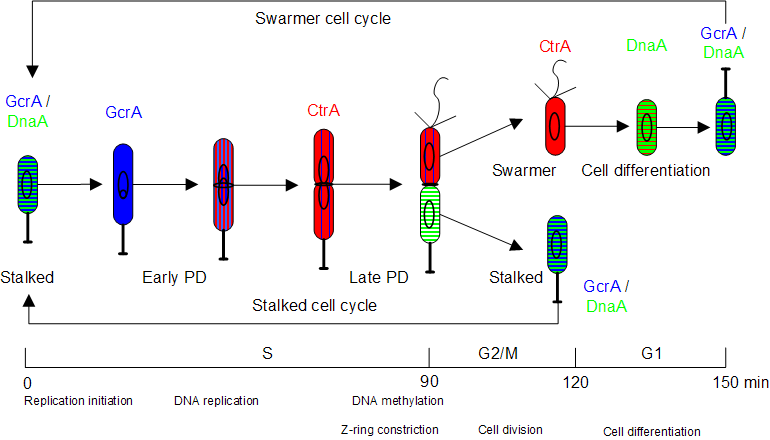Biological background
Caulobacter crescentus
Caulobacter crescentus is a dimorphic bacterium which inhabits freshwater, seawater and soils, where it plays an important role in global carbon cycling by mineralizing dissolved organic materials (Poindexter, 1981). Caulobacternormally undergoes an asymmetric cell division cycle producing two different progeny cells (Fig 1): a motile, flagellated swarmer cell and a sessile stalked cell (Ausmees and Jacobs-Wagner, 2003; Brun and Shimkets, 2000; Ryan and Shapiro, 2003). The two cells undergo two different developmental programs. The nascent stalked cell immediately enters into a new round of cell division and produces, about 90-120 min later, a new swarmer cell. The nascent swarmer cell swims around for 30-45 min before it differentiates into a stalked cell and initiates the DNA replication-division cycle.

Figure 1. Physiology of the cell division cycle in Caulobacter. Three cell cycle phases can be distinguished in a swarmer cell of Caulobacter crescentus: a growth and differentiation (G1) phase that lasts ~30 min, a DNA synthesis (S) phase that takes ~90 min, and a late pre-divisional (G2/M) phase, lasting ~30 min, that culminates in the separation of mother (stalked) and daughter (swarmer) cells. The stalked cell cycle lacks G1 phase. The color scheme denotes protein variations through the cell division cycle: GcrA (blue), CtrA (red), DnaA (green). The Thelta-like structure denotes replicating DNA during the cell cycle.
Cell cycle control in Caulobacter
Because of its easy manipulation in laboratory, Caulobacter has become a model organism to investigate cell cycle regulation in bacteria (Ausmees and Jacobs-Wagner, 2003;Ryan and Shapiro, 2003). Of Caulobacter's 3760 protein-coding genes, about 550 are regulated in a cell-cycle-dependent manner (Laub, McAdams et al. 2000), in large part by three regulatory proteins: CtrA, GcrA and DnaA, which together control the expression of 185 cell-cycle regulated genes (Laub, Chen et al. 2002; Milo, Shen-Orr et al. 2002; Collier, Murray et al. 2006; Collier, Shen et al. 2007). CtrA upregulates the expression of many genes involved in cell division: DNA methylation, flagella, stalk, and septal Z-ring biogenesis (Kelly, Sackett et al. 1998; Biondi, Skerker et al. 2006) (Fig. 2). In addition, CtrA binds to five DNA sites that overlap with the binding sites of the replication initiation protein, DnaA, and thereby precludes a new round of DNA replication (Quon, Yang et al. 1998). Furthermore, CtrA inhibits the expression of GcrA, which functions as an activator of components of the replisome and the segregation machinery (Holtzendorff, Hung et al. 2004).
 webmaster
webmaster